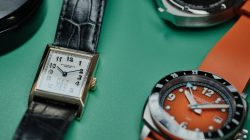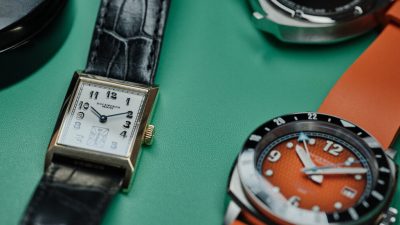“Amore,” Hugh Findletar shouted. “Amore!”
The words echoed through Studio Salvadore, a family-run glassblowing workshop on Murano, the Italian island near Venice known for its centuries-old glass industry. It was 3 p.m. on a Friday in late July, and Mr. Findletar had been making drinking glasses with a small team since around 6:30 in the morning. The temperature near the studio’s furnaces had risen to as high as about 120 degrees.
At the mouth of a furnace, colorful glass rods lined up on the head of a shovel were melting together. Mr. Findletar, 49, flicked water droplets at the glass, which would become a cup, to make bubbles. Then he moved to a table with bowls full of ground glass that looked more like sand. He took pinches of the particles, in shades of lemon yellow and Campari red, and dusted them onto the cup to create splotches.
“I call this dirtying up the glass,” Mr. Findeltar said. Some of the pieces being made that day were for India Mahdavi, an interior designer and architect, who is starting to sell his glassware at her namesake boutique in Paris.
Though Mr. Findeltar makes housewares like cups, he is perhaps best known for his bust-like vases, which he calls “flowerheadz.” The “z,” he said, is for his daughter, Zadie, who was named after the writer Zadie Smith. He uses the letter liberally: Mr. Findletar refers to his pieces collectively as “glassz,” and he has made sculptures of horses, fish and shells that he calls “horseheadz,” “fishiez” and “shellz.”
The flowerheadz vases are usually based on people, and he has made versions inspired by the model Naomi Campbell, a doorwoman who works at his apartment building in Milan and Solomon, the biblical king. The pieces start at $25,000, and Mr. Findletar encourages buyers to fill them with flowers. (He likes cattail, anthurium, hydrangea and palmetto, which he said create dramatic hairdos.)
Angela Missoni, 65, the president of the Missoni fashion brand, has bought three of the vases, including the King Solomon edition. Ms. Missoni compared arranging flowers in the pieces to “taking them to the hairdresser.”
Other collectors include Marina Prada, the sister of Miuccia Prada, and the designers Domenico Dolce and Stefano Gabbana, who have commissioned flowerheadz vases in their likenesses. King Mohammed VI of Morocco bought a school of eight fishiez sculptures at L’Éclaireur, a luxury store in Paris. (Each cost about $7,500.)
Glass by Way of Photography
In September, Mr. Findletar will introduce new flowerheadz vases at Bergdorf Goodman in Midtown Manhattan, as part of a group art show hosted by the Spaceless Gallery in the department store’s home décor section.
Some of the pieces are modeled after people connected to New York, including the jazz singer Billie Holiday; Patricia Field, the merchant turned “Sex and the City” costume designer; and Jacqueline Kennedy Onassis, who Mr. Findletar rendered in bubble-gum pink, a reference to the color of the Chanel suit she was wearing on the day her first husband, President John F. Kennedy, was shot.
Mr. Findletar typically works with five other artisans to create each flowerheadz vase. (Ears are applied last.) He has been working with many of the same people for more than a decade. “When I start with somebody, there’s a wedding,” he said of the professional bonds he has made.
His path to becoming a glass artist — and to Murano, where he lives on most weekends — was not exactly direct.
Mr. Findletar was born in Jamaica and was raised by his maternal grandparents and great-grandparents, who ran a banana and coffee farm in St. Ann Parish, until he was 8. His interest in flowers, he said, came from his childhood in what’s known as Jamaica’s garden parish.
He then moved to New York and lived with his parents in Brooklyn. His early jobs in the city included working for a political club and managing the floor at a home décor shop, Mr. Findletar said. He also worked as a housekeeping supervisor at a hotel on the Upper East Side, which is now closed. He recalled Tina Turner staying there. “I went and smelled everything in her room,” he said.
In the late 1980s, Mr. Findletar started working as an assistant to the photographer Ken Nahoum, who specialized in celebrity portraiture. Later, in the 1990s, he assisted other photographers, including Michel Comte on shoots with Sophia Loren and other notable subjects. Around the same time, Mr. Findletar also began working as a photographer; his portraits have appeared in The New York Times and elsewhere.
“For a long time, my career was only photography,” he said.
He had moved from New York to Milan by the time he went to Kenya in 1999 on a photography job for the Italian edition of Marie Claire. He stayed in Kenya for about a month, he said, and during that time he visited Anselm’s Kitengela Hot Glass, a glassblowing studio on the outskirts of Nairobi, where he started taking lessons in the craft.
Mr. Findletar said he first made vases that he would use for floral arrangements, some of which he would photograph. He also began to experiment with making glass masks, after buying a wooden mask made by members of Kenya’s Kikuyu tribe.
Eventually, Mr. Findeltar said, he thought, “What if I put a mask on a vase, and flowers in the vase?”
“Ding-dong!” he added of the idea that became the foundation for his flowerheadz pieces.
Mr. Findeltar pursued glass work as a hobby for about a decade while continuing to work as a photographer. He became more serious about glass, he said, after being invited to show some vases at the 2013 edition of Germany’s International Design Week. Before the festival, Mr. Findletar went to Murano to refine his technique. He said the island is one of the very best places to be for glass.
An ‘Outsider-Outsider’ in Venice
On the island he met Oscar Zanetti, the head of Zanetti Murano, a glassblowing studio that Mr. Zanetti’s family has operated since the 1950s.
“He’s a character,” Mr. Zanetti, 62, said of Mr. Findletar. “I liked him. I liked his ideas.” But he “didn’t know glass well when he arrived and really had to try hard to learn,” Mr. Zanetti said.
Around the time Mr. Findletar started working with Mr. Zanetti, he met Lino Tagliapietra, another master glassblower, at a bar on Murano. (Mr. Tagliapietra has collaborated on various projects with the artist Dale Chihuly.) Mr. Findletar said he helped advance his understanding of the theory of glass as a modern art.
Mr. Findeltar, who now rents work space at Mr. Zanetti’s studio and others on Murano, is among a handful of Black glass artists who have penetrated the native industry in Venice, said Adrienne Childs, an art historian and an associate at the W.E.B. Du Bois Research Institute at Harvard. Others include Fred Wilson, a Black American artist whose black glass chandeliers were made on Murano, and the Senegalese artisan Moulaye Niang, who studied at the Abate Zanetti School of Glass — Venice’s only glassmaking school — and helped found a studio, Muranero, in the city.
Outsiders in the field are not usually Black, Mr. Findletar said. He described himself as an “outsider-outsider” — or a particularly rare presence — on Murano and in Venice. “I consider myself a Moor in all this,” he added, using a term once used in Europe to describe Muslims and people from Northern Africa, and which was later used to generally describe people with dark skin, like Shakespeare’s character Othello.
Dr. Childs said that decorative objects called blackamoors, which portray Black people in problematic ways, are still made in Venice. They typically feature Black servants and enslaved people, she said, dressed in fashionable livery that represented the wealth of their owners or employers.
Reni Folawiyo, the owner of Alára, a boutique in Lagos, Nigeria, brought four of Mr. Findletar’s vases to a pop-up shop she curated for this year’s “Africa Fashion” exhibition at the Brooklyn Museum, which runs through October.
Ms. Folawiyo said that from the 1970s to the 1990s, Venetian glass tiles and chandeliers were considered status items in Nigerian homes. By supporting Mr. Findletar, she said, she is hoping to raise his profile in Africa and to boost its glassblowing industry.
“Our diaspora is very important to the story we tell,” she said. “I think more people need to know Hugh’s work.”
Mr. Findletar is also attempting to promote the African glass industry, he said, by developing a series of glass masks informed by Venetian romanticism with the studio in Kenya where he learned the basics of glassblowing.
He said he sees making the flowerheadz vases as a way of trying to repopulate the planet with “my people of every color, even green.” (He gives some pieces a green complexion similar to the color of bamboo canes.) He added that, through his work, he is “bringing that Rift Valley energy to Venice,” referring to the swath of East Africa where some of humans’ oldest ancestors lived.
As he put it, “I’m playing God.”
Sumber: www.nytimes.com












